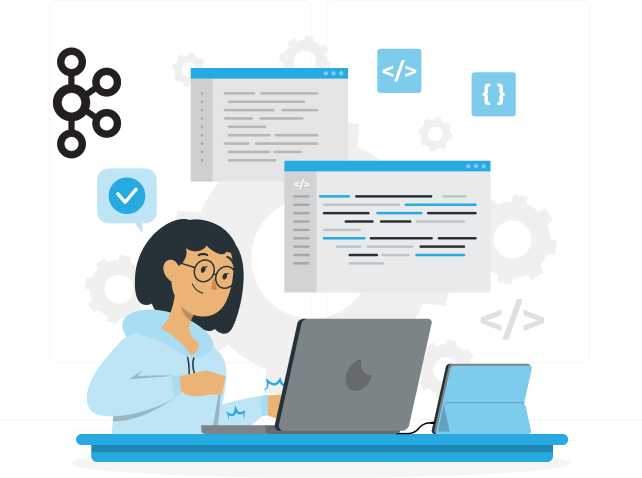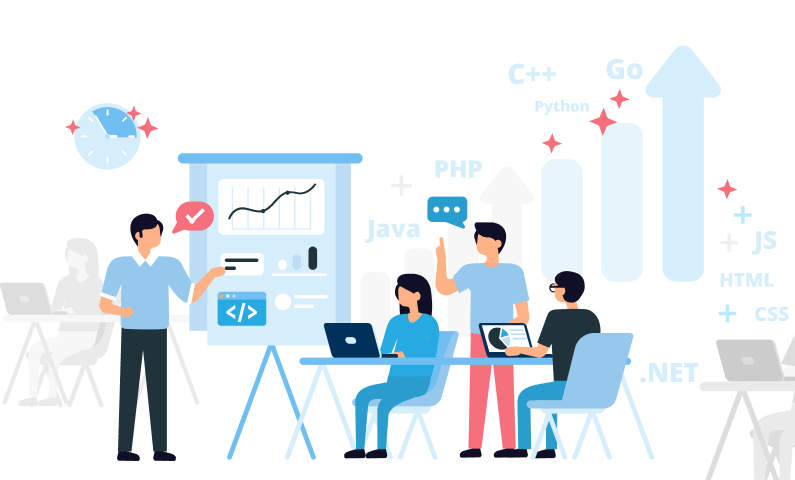The last few years have seen a critical change in educational technology, or EdTech: From integrating digital tools to really make learning experiences better for people, according to a group of EdTech experts. For educational organizations, however, the shift raises a particular conundrum: to opt for ready-made, general-purpose software, or bespoke, tailor-made solutions built to fit specific needs. It is crucial to learn custom software vs off the shelf programs in edtech industry before making an investment.
This blog explains the fundamental deciding factors between such alternatives. It goes on to discuss costs, flexibility, technical compatibility, and scalability and includes case studies, real-world examples, and technical perspectives to help guide institutions in selecting the proper options for their investments in technology.
Custom Vs Off The Shelf Software in Edtech: An Overview
Upon making this decision, one must understand the basic differences between custom and off-the-shelf software.
Off-the-Shelf Software (OTS): Commercial off-the-shelf software is packaged and prepared for wide usage. It is typically easier to deploy, normally less expensive at outset, and generally has standard features that benefit a large audience.
Custom (Bespoke) Software: Custom software is designed and developed uniquely to meet a specific organization’s needs. This often involves a more significant initial investment in upfront development time, but the software is tailored specifically for special, unique institutional goals.
Advantages of Off-the-Shelf Software in EdTech
OTS software has several advantages for implementing a quick and affordable solution in the education institution:
OTS systems such as shelf design software or classroom management apps are very readily available, permitting educational organizations to get started quickly without undertaking the long time-consuming process of building.
Lower Front-end Cost: The reason why off-the-shelf software solutions are mass-produced reduces their initial cost when compared to custom software, thus making them more susceptible to budget-conscious institutions.
Reliability and Support: Most of the off-the-shelf applications have been proven by thousands of users; this often translates to reliable operation, frequent updates, and customer support.
Examples of OTS Apps in Education: Some of the best OTS solutions are Google Classroom and Microsoft Teams, which are widely employed in academic settings. These applications provide ready-to-use basic functionality for virtual classrooms, sharing documents, and assignment management.
Still, there’s a trap with OTS solutions: you can’t customize it too much. It becomes quite a problem for educational institutions to configure the software according to certain workflows, compliance requirements, or unique teaching methodologies.
Advantages of Custom Software in EdTech
Custom software offers unmatched flexibility, and for institutions that have special or complex needs, it is the best solution:
Very Tailored to Need: As in the case of custom software, you can structure features and workflows that fit the specific needs of institutions. For example, a customized learning management system may be particularly structured for STEM learning or language acquisition.
Custom software development processes allow for smooth integration with other systems and platforms. For example, a university would be able to integrate its student portal with the LMS and financial aid systems with no problems at all-whereas OTS solutions are usually highly incompatible.
Data Security and Privacy: In EdTech industries for example, the data of students cannot be compromised and the uses of custom software can afford more security protocols-tailored to adhere to the compliance standards.
Scalability: Custom solutions can scale with an institution’s growth. Given this, custom solutions are much more flexible than off-the-shelf systems in that respect.
Examples of Custom Software in EdTech: Khan Academy and Coursera offer custom-built software specific to some set of learning goals. The features are unique to their approach, which makes them ultra-personalized for the user.
1.Scalability and Flexibility: Comparison of Custom Software vs. Off-the-Shelf
Custom software is flexible and adaptable for the changing needs of the institution. For instance, a custom LMS may be built to support new formats or multimedia features. This would not be possible for off-the-shelf systems that may already have fixed capabilities in place or rely on third-party tools to add new functions.
2. Cost and Development Time
Off-the-shelf software: Off-the-shelf software is quicker to set up and cheaper in institutional environments that require an immediate solution. Custom software: Custom software takes longer to develop, more expensive up front, but can provide better ROI downstream.
3. Security and Compliance
Custom software enables the developers to focus on data security in compliance with specific regulations; for educational purposes, it is all the more sensitive with regard to student information. While off-the-shelf options guarantee security, they could not have the very kinds of features that might be necessary for institutions, such as multi-level access controls and site-specific encryption methods.
4. User Experience and Customization Options
Institutions that have unique characteristics would find OTS solutions restrictive in terms of the UI and functionality. Customized LMS software could provide user-specific dashboards and metrics depending on their user groups, namely administrators, teachers, and students; off-the-shelf package is more generic than this.
Technical Comparison of Custom and Off-the-Shelf Solutions
Interoperability with Legacy Systems: If an institution already has an existing system in place, its integration capabilities would be significantly better than those of OTS systems.
Customization: Pre-developed database software does not provide the exact form of customization needed to analyze specific types of data or to deliver a specific form of report; whereas, custom solutions make available full-scale database management.
Implementation of Emerging Technologies: Custom EdTech applications can very well include AI, VR, and other emerging technologies that give some added advantage above the others. OTS solutions may lag behind in implementing the latest trends in technology and thereby limit innovation capabilities.
Hybrid Implementation Hybrid Approach: Custom and OTS Solution
Hybrid is the most adopted approach by many educational institutions. It reaps benefits from both custom and OTS software. While core operations are dealt with by an off-the-shelf system, specific modules could be developed based on particular needs.
Thus, Google Classroom can be used for basic management of the institution activities, but a module for testing format has been customized.
It mainly depends on viewing short-term and long-term goals and determining that which will be more beneficial and beneficial to each institution to introduce the software.
Institution’s Budget and Timeline: Very limited budget or having a tight timeline can begin with OTS software and scale up with custom modules later.
Growing Institution or High Growth: Custom software would be perfect for institutions where the growth is going to be enormous. The long-term options of OTS solutions might have to eventually be either replaced or supplemented heavily as the need grows for a bigger solution, but it could be possible to incrementally scale the custom solution.
For an institution with specific needs, a custom, ‘bespoke’ solution, no matter the high initial cost, is often the better option because it guarantees a specific fit for the certain needs.
On the other hand, one significant advantage of a custom solution is dedicated support. This might be of paramount importance for a number of institutions that always require technical support.
Bespoke software or off-the-shelf software is an important choice in the changing world of EdTech. First of all, with off-the-shelf technology, one can talk about its cost efficiency, speed of deployment, and should be able to fill most general needs where big budgets are not available.
With custom software, as concerns go, organizations have unique opportunities when they have special needs, like scalability, user-experience-based requirements, and data security issues.
Challenges of Off-the-Shelf Solutions in EdTech
While OTS software is equally inexpensive and easy to deploy, it is also characterized by some disadvantages:
Low Degree of Customization: OTS solutions are not very flexible when there are specific requirements in terms of workflows; an institution will have to change its workflow to accommodate the software, and not vice versa.
Scalability: With a rise in user base or functionality, an institution requires more scalability in their OTS solutions.
Hidden Costs: While off-the-shelf software may have lower initial costs, licensing fees that may be involved in third-party integrations as well as a hidden cost when the vendor controls the version of the software a university wants.
Examples of OTS Limitations:
A medium-sized university began using Google Classroom for all its classes, which was working very effectively. However, after a while, there were limitations-especially in specialised requirements like tracking student engagement and integrating with other softwares for research purposes.
The Hybrid Solution: Custom and Off-the-Shelf Software Combination
A hybrid approach enables educational institutions to take advantage of the best of both worlds-in that they have off-the-shelf availability of software for core functionalities, and at the same time, custom development takes place for specialized requirements.
Case Study Example: General management will be through the Google Classroom module, but a customized assessment module will be added to cater to the grading system peculiar to this institution, and also to state-specific requirements of the particular state in the U.S.
Database software developed in conjunction with a custom dashboard: An educational institute may use off-the-shelf database software to store student data but develop a custom dashboard to monitor the progress of individual students and personalized learning outcomes.
Example in Application: A school that is utilizing the platform Microsoft Teams in its various administrative operations will create an add-on specific to the workflows it identifies as needing improvement, whereupon the system generally is useful for their purpose, while uniquely doing the same.

Source: Taaza
New Trends in EdTech: Impact of Custom and Off-the-Shelf Software
Artificial Intelligence and Machine Learning: AI-based personalization also falls into the category of EdTech. Customized software can easily integrate AI in adaptive learning experiences, whereas OTS options may be restricted in terms of AI capabilities due to generalized design.
Remote and Hybrid Learning: Remote learning is slowly becoming the trend in education. Accordingly, software must provide a comprehensive set of functionalities from virtual classrooms to student assessments. Custom solutions can be accomplished based on such varied requirements, while off-the-shelf may not provide all advanced remote learning functionalities.
Data Privacy and Compliance: With data privacy compliance turning into very strict laws, educational institutions require software that is compliant with FERPA and GDPR. Custom solutions have controls for privacy in them, though OTS solutions may not have such immediate implementation and need further measures to be deployed for compliance.
Mobile-First Learning: Today, institutions are giving more priority to mobile-friendly platforms. With custom software solutions, flexibility exists to design mobile-first applications. However, in off-the-shelf mobile applications, no optimization for mobile usage or particular devices may exist.
Conclusion:
Therefore, in choosing between customization or off-the-shelf software, educational institutions need to consider objectives, resources, and specific needs before deciding on one or the other types of the software. Off-the-shelf technology is undoubtedly ideal for most institutions seeking quick solutions that may provide generalized features at budget-friendly costs. For organizations with very specific requirements that may evolve with time, a customized solution can provide greater control, scalability, and integration potential.
A hybrid approach might similarly be able to provide the best of both worlds by using off-the-shelf software for its core needs and developing custom modules for specific functions. After all, the solution you finally settle on should support your institution’s specific educational goals, providing seamless, productive digital experiences for both educators and students.
If you are a business looking to develop custom software or off the shelf programs in edtech industry, we are here to help you with it! Let’s speak!

Start a Project with Ajackus











































































